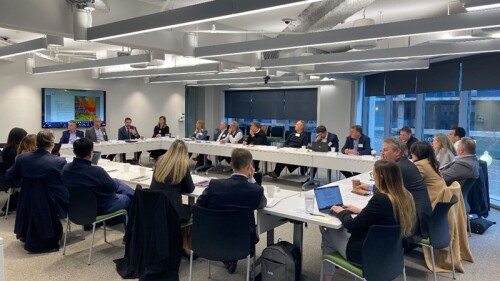Making public parking easier has largely been a success in San Francisco, reducing wasted time and gas for drivers cruising for a space, and cutting down on double-parking, an inconvenience and a safety threat to all.
Who would want to make driving easier in San Francisco? A region that is pro-transit, pro-environment, and somewhat anti-car, with bridge tolls required to enter the city from three sides, would seem an odd place to facilitate driving. However, the primary goal of SFpark—a major initiative in San Francisco—is to make it easy to find a parking space. The rationale behind the initiative is a belief that drivers unable to find a space on the street will cruise around or double-park, adding to congestion and making matters worse for everyone.
Register for the ULI Fall Meeting
Metered parking spaces in San Francisco were chronically full during peak times, requiring drivers to cruise around nearby streets until an empty spot was found, double-park, or go home in frustration. The aforementioned program, SFpark, was initiated in 2009, with funding from a Federal Highway Administration Urban Partnership, and managed by the San Francisco Municipal Transit Agency, which also manages the city’s transit agency. The primary goal of SFpark is “to make it easy to find a parking space. . . . SFpark aims to manage demand for existing parking so that drivers, when they choose to drive, rarely circle to find parking or double-park. To the extent the right level of parking availability is maintained, everyone benefits.”
The planning and development started with a census of parking spaces, something that SFpark believes does not exist in other major cities. The census estimated there were 441,000 parking spaces, of which 27,000 were metered spaces on the street, 249,000 were unmetered spaces on the street, and 171,000 were off-street spaces, most in paid facilities. Six pilot areas were established, where parking rates would be regularly adjusted to meet market demand. Where parking demand filled up all the spaces, rates would be increased, and where spaces were plentiful, rates would be lowered. An evaluation of early experience conducted in 2014 yielded positive results: “SFpark: Putting Theory into Practice Pilot Project Summary and Lessons Learned.” Adjustments were made for street meters as well as those in city-operated parking garages.
Finding spaces, filling spaces. The primary goal was to reduce blocks with high occupancy, defined as having greater than 85 percent of the spaces occupied. Once use exceeds this level, it seems to drivers that all spaces are filled. With use of a basic supply/demand principle—namely, that higher prices result in lower demand—meter rates on high-demand blocks were gradually increased to bring demand in line with goals. Over the course of the SFpark pilot project evaluation, the average meter parking rate was actually reduced 11 cents, from $2.69 to $2.58 per hour, and hourly rates at SFpark garages were reduced 42 cents, from $3.45 to $3.03. The higher rates reduced demand, while the lower ones increased it. The desired parking occupancy of 60 to 80 percent increased by 31 percent in study areas, and the amount of time that blocks were too full to find parking decreased by 16 percent. This demand-based variable pricing approach was found to be generally successful as a tool to better balance and distribute on-street parking within the city.
Reduced cruising. Making more spaces available to arriving drivers reduced the amount of time that it took for most people to find a space by 43 percent, a substantial improvement in convenience for parkers. When a few spaces are always available, drivers spend less time circling for parking. SFpark also shortened the distance drivers had to travel before finding a spot. The average search distance decreased by 30 percent, with proportional reductions in pollution from greenhouse gases.
Average speeds increased because of the reduced congestion. And the program even reduced the number of parking tickets. Double-parking dropped by 22 percent in study areas, and transit speeds in those areas increased by 2 percent. Moreover, better availability and easier parking methods resulted in 36 percent fewer parking meter–related citations per meter than before the pilot.
Does it pencil out? The focused management and better technology for parking have clearly produced many benefits. Were they worth the considerable costs? One of the evaluation measures included in the federal evaluation totaled up all the costs and benefits. As part of the federal evaluation, the costs and benefits were projected out over ten years. It found that the costs for planning, design, and construction in 2011 dollars were almost $42 million. Interestingly, the benefits did not include extra meter revenues, since average meter fees went down, not up. Societal benefits included the value of travel time savings (which accounted for the lion’s share of benefits), reduced emissions, and reduced fuel consumption and operating costs. All told, the benefits were estimated at 74 percent of the costs—not quite a complete payback; but on the other hand, they did not include all benefits, and involved significant costs for sensors and other technology, which might be avoided with a simpler project.
The demand-based pricing of SFpark succeeded in reducing the number of blocks with high occupancy and increasing the occupancy on underused blocks. According to the city’s evaluation, “for travelers, reduced parking occupancy in congested areas meant parking was more readily available and led to reduced time to find parking, which meant lower vehicle miles traveled and emissions in pilot areas. Bus ridership increased in the pilot areas, but few travelers appeared to change mode as a direct result of parking pricing.” The program required strong leadership to establish clear parking goals, and implement changes on such a mundane issue, where changes can easily incite the ire of residents and businesses.




